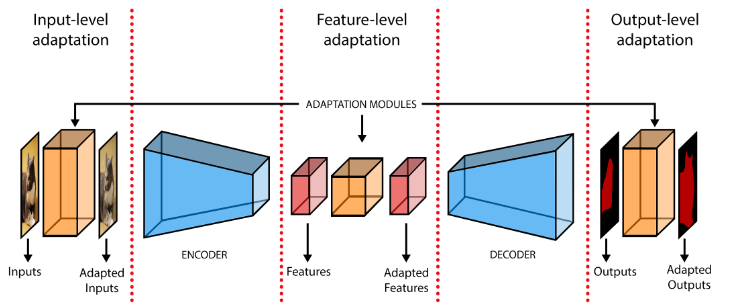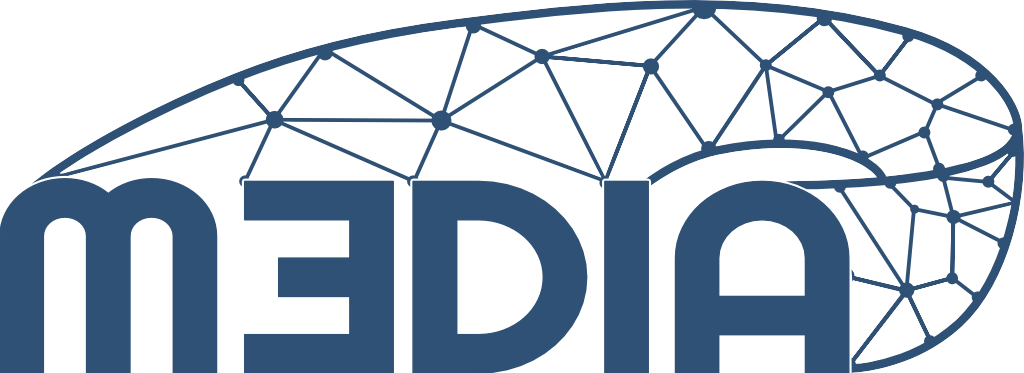Unsupervised Domain Adapatation (UDA) for semantic segmentation is the task of aligning a network trained on source data to perform well on target data with a related but different statistical distribution. Complex deep neural networks for this task require to be trained with a huge amount of labeled data, which is difficult and expensive to acquire. A recently proposed workaround is to use synthetic data, however the differences between real world and synthetic scenes limit the performance. UDA techniques allow to reduce this gap allowing to obtain reliable performances on the target domain. We presented an overview of the recent advancements in the Unsupervised Domain Adaptation (UDA) of deep networks for semantic segmentation.

Key research topics include:
- We proposed an unsupervised domain adaptation strategy that combines adversarial learning and self-teaching.
- An improved adversarial module driven by a couple of fully convolutional discriminators dealing with different domains is introduced.
- We propose an UDA strategy to address the domain shift issue between real world and synthetic representations focusing on mobile devices.
- We propose a novel Unsupervised Domain Adaptation (UDA) strategy, based on a feature clustering method that captures the different semantic modes of the feature distribution
- The combination of UDA and Continual Learning has been tackled.
- Domain adaptation has also been tackled in a federated learning setting.
Recent publications:
When Cars meet Drones: Hyperbolic Federated Learning for Source-Free Domain Adaptation in Adverse Weather Proceedings Article
In: Proceedings of the IEEE/CVF Winter Conference on Applications of Computer Vision (WACV), 2025.
Enhanced Model Robustness to Input Corruptions by Per-corruption Adaptation of Normalization Statistics Proceedings Article
In: IEEE, (Ed.): IEEE/RSJ International Conference on Intelligent Robots and Systems (IROS), 2024.
Learning with Style: Continual Semantic Segmentation Across Tasks and Domains Journal Article
In: IEEE Transactions on Pattern Analysis and Machine Intelligence, 2024.
FFT-based Selection And Optimization Of Statistics For Robust Recognition Of Severely Corrupted Images Proceedings Article
In: IEEE International Conference on Acoustics, Speech and Signal Processing (ICASSP), 2024.
Source-Free Domain Adaptation for RGB-D Semantic Segmentation with Vision Transformers Proceedings Article
In: Proceedings of the IEEE/CVF Winter Conference on Applications of Computer Vision, pp. 615–624, 2024.
Road scenes segmentation across different domains by disentangling latent representations Journal Article
In: The Visual Computer, vol. 40, no. 2, pp. 811-830, 2024.
Continual coarse-to-fine domain adaptation in semantic segmentation Journal Article
In: Image and Vision Computing, vol. 121, pp. 104426, 2022.
Unsupervised domain adaptation in semantic segmentation via orthogonal and clustered embeddings Proceedings Article
In: Proceedings of the IEEE/CVF Winter Conference on Applications of Computer Vision, pp. 1358–1368, 2021.
Adversarial learning and self-teaching techniques for domain adaptation in semantic segmentation Journal Article
In: IEEE Transactions on Intelligent Vehicles, vol. 5, no. 3, pp. 508–518, 2020.
Unsupervised domain adaptation for mobile semantic segmentation based on cycle consistency and feature alignment Journal Article
In: Image and Vision Computing, vol. 95, pp. 103889, 2020.
Unsupervised domain adaptation in semantic segmentation: a review Journal Article
In: Technologies, vol. 8, no. 2, pp. 35, 2020.
Enhanced Model Robustness to Input Corruptions by Per-corruption Adaptation of Normalization Statistics Conference
International Conference on Intelligent Robots and Systems (IROS), 0000.
